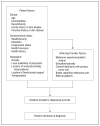Distance to diagnosing provider as a measure of access for patients with melanoma
- PMID: 17709657
- PMCID: PMC3629703
- DOI: 10.1001/archderm.143.8.991
Distance to diagnosing provider as a measure of access for patients with melanoma
Abstract
Objective: To examine the effect of travel distance and other sociodemographic factors on access to a diagnosing provider for patients with melanoma.
Design: Analysis was performed of all incident cases of melanoma in 2000 from 42 North Carolina counties.
Setting: Academic research.
Participants: Patients and providers from 42 North Carolina counties were geocoded to street address.
Main outcome measures: Associations between Breslow thickness and clinical and sociodemographic factors (age, sex, poverty rate, rurality, provider supply, and distance to diagnosing provider) were examined.
Results: Of 643 eligible cases, 4.4% were excluded because of missing data. The median Breslow thickness was 0.6 mm (range, 0.1-20.0 mm). The median distance to diagnosing provider was 8 miles (range, 0-386 miles). For each 1-mile increase in distance, Breslow thickness increased by 0.6% (P =.003). For each 1% increase in poverty rate, Breslow thickness increased by 1% (P =.04). Breslow thickness was 19% greater for patients aged 51 to 80 years than for those aged 0 to 50 years (P =.02) and was 109% greater for patients older than 80 years than for those aged 0 to 50 years (P < .001). Sex, rurality, and supply of dermatologists were not associated with Breslow thickness.
Conclusions: For patients with melanoma, distance to the diagnosing provider is a meaningful measure of access that captures different information than community-level measures of rurality, provider supply, and socioeconomic status. Future work should be targeted at identifying factors that may affect distance to diagnosing provider and serve as barriers to melanoma care.
Figures



Similar articles
-
The role of circumstances of diagnosis and access to dermatological care in early diagnosis of cutaneous melanoma: a population-based study in France.Arch Dermatol. 2010 Mar;146(3):240-6. doi: 10.1001/archdermatol.2010.10. Arch Dermatol. 2010. PMID: 20231493
-
Influence of provider and practice characteristics on melanoma care.Am J Surg. 2007 Feb;193(2):206-12. doi: 10.1016/j.amjsurg.2006.06.038. Am J Surg. 2007. PMID: 17236848
-
Association of rurality and health professional shortages with the clinicopathologic characteristics of melanoma in North Carolina.J Rural Health. 2025 Mar;41(2):e12881. doi: 10.1111/jrh.12881. Epub 2024 Oct 3. J Rural Health. 2025. PMID: 39363437
-
The impact of demographics, socioeconomics, and health care access on melanoma outcomes.J Am Acad Dermatol. 2021 Jun;84(6):1677-1683. doi: 10.1016/j.jaad.2020.07.125. Epub 2020 Aug 9. J Am Acad Dermatol. 2021. PMID: 32783908 Review.
-
Are all melanomas dangerous?Acta Derm Venereol. 2011 Sep;91(5):499-503. doi: 10.2340/00015555-1177. Acta Derm Venereol. 2011. PMID: 21874217 Review.
Cited by
-
Proposal for an annual skin examination by a general practitioner for patients at high risk for melanoma: a French cohort study.BMJ Open. 2015 Jul 29;5(7):e007471. doi: 10.1136/bmjopen-2014-007471. BMJ Open. 2015. PMID: 26224016 Free PMC article. Clinical Trial.
-
Unusual documentation of the transformation of a nevus into malignant melanoma.J Clin Aesthet Dermatol. 2009 Jan;2(1):41-3. J Clin Aesthet Dermatol. 2009. PMID: 20967188 Free PMC article.
-
Distance as a Barrier to Cancer Diagnosis and Treatment: Review of the Literature.Oncologist. 2015 Dec;20(12):1378-85. doi: 10.1634/theoncologist.2015-0110. Epub 2015 Oct 28. Oncologist. 2015. PMID: 26512045 Free PMC article. Review.
-
Travel time to provider is associated with advanced stage at diagnosis among low income head and neck squamous cell carcinoma patients in North Carolina.Oral Oncol. 2019 Feb;89:115-120. doi: 10.1016/j.oraloncology.2018.12.029. Epub 2019 Jan 2. Oral Oncol. 2019. PMID: 30732948 Free PMC article.
-
Rural residence and cancer outcomes in the United States: issues and challenges.Cancer Epidemiol Biomarkers Prev. 2013 Oct;22(10):1657-67. doi: 10.1158/1055-9965.EPI-13-0404. Cancer Epidemiol Biomarkers Prev. 2013. PMID: 24097195 Free PMC article. Review.
References
-
- Chang AE, Karnell LH, Menck HR American College of Surgeons Commission on Cancer and the American Cancer Society. The National Cancer Data Base report on cutaneous and noncutaneous melanoma: a summary of 84,836 cases from the past decade. Cancer. 1998;83(8):1664–1678. - PubMed
-
- Berwick M, Begg CB, Fine JA, Roush GC, Barnhill RL. Screening for cutaneous melanoma by skin self-examination. J Natl Cancer Inst. 1996;88(1):17–23. - PubMed
-
- Balch CM, Soong SJ, Gershenwald JE, et al. Prognostic factors analysis of 17,600 melanoma patients: validation of the American Joint Committee on Cancer melanoma staging system. J Clin Oncol. 2001;19(16):3622–3634. - PubMed
-
- Bono A, Bartoli C, Cascinelli N, et al. Melanoma detection: a prospective study comparing diagnosis with the naked eye, dermatoscopy and telespectrophotometry. Dermatology. 2002;205(4):362–366. - PubMed
-
- Wolf IH, Smolle J, Soyer HP, Kerl H. Sensitivity in the clinical diagnosis of malignant melanoma. Melanoma Res. 1998;8(5):425–429. - PubMed
Publication types
MeSH terms
Grants and funding
LinkOut - more resources
Full Text Sources
Medical

